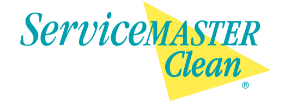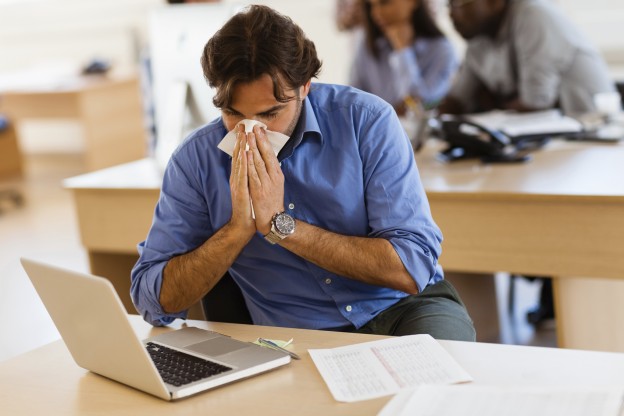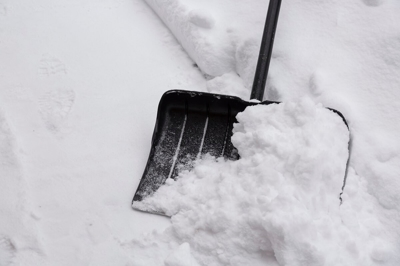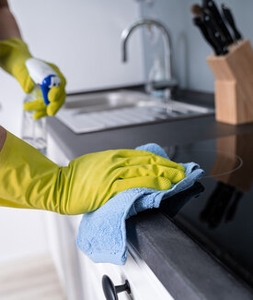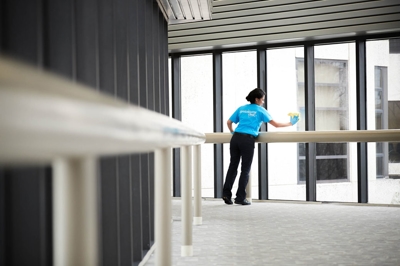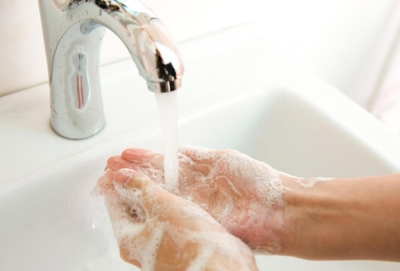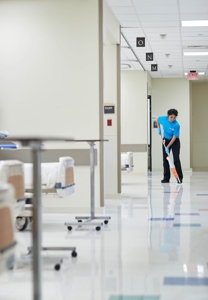Cleaning and Disinfecting Tips for Businesses Affected by Coronavirus (COVID-19)
With some businesses opening as the COVID-19 pandemic continues, maintaining a clean workplace is critical to helping fight the spread of this disease.
Current data suggests that SARS-CoV-2, the virus that causes COVID-19, spreads through respiratory droplets produced when an infected person speaks, coughs, or sneezes. Transmission may occur directly, or it can happen through contact with contaminated surfaces, followed by contact with the eyes, nose, or mouth.
The first step in helping contain this new coronavirus is to try and reduce its spread through the appropriate use of protective equipment. The next is to take appropriate steps to clean and disinfect surfaces that may be contaminated. We’ll discuss how to do both.
COVID-19 Cleaning Tips and Prevention
There’s a lot of information—and even more opinions—floating around about the current pandemic. Here is some basic information to know and first steps to take in order to maintain the cleanest, safest environment that you can.
Know the terms.
Knowing what you’re up against is a big part of fighting it. Let’s take a moment to make sure everyone’s on the same page.
- Coronavirus is a broad category of viruses. There are seven known coronaviruses that can infect people. They were first identified in the 1960s. You may hear people call this latest one “the new coronavirus” or “the novel coronavirus” to specify which one they’re talking about.
- SARS-CoV-2 is the name of the newest coronavirus, discovered last year.
- COVID-19 is the disease that caused by SARS-CoV-2. The name tells you that it is the COronaVIrus Disease that was discovered in 2019.
Know the difference between cleaning and disinfecting
“Cleaning” means removing dirt and impurities from surfaces. It doesn’t kill germs, but it decreases the number of germs on a given surface, helping reduce the risk of infection.
“Disinfecting” refers to killing germs, usually with chemicals like EPA-registered disinfectants. The surface may not necessarily look cleaner, and the germs may still be present, but they will be dead.
The best approach is a cleaning/disinfecting one-two punch. Clean surfaces to remove the bulk of the germs and to get rid of dirt. Then disinfect the surfaces to kill any germs that may remain.
Educate your employees on appropriate handwashing procedures.
Make sure that employees wash their hands thoroughly, for the full recommended 20 seconds. There’s no shortage of 20-second songs people can use to help time this out. And there’s a lot of light-hearted signage you can find on the Internet to encourage good handwashing technique without feeling overwhelming or scary.
In situations where hand-washing is not an option, use an alcohol-based hand sanitizer with at least 60% alcohol content. You may be able to make a DIY hand sanitizer in a pinch, but make sure that it contains at least 60% alcohol, and use instructions from a reliable source.
Encourage your employees not to come to work when they feel ill.
There are many industries where coming in sick (also known as “presenteeism”) is an unspoken norm. In one study, 12% of restaurant workers said that they came to work despite experiencing diarrhea and/or vomiting. A different study of American workers in general found that 57% sometimes come in sick, while 33% always come in, even if they’re sick. All together, that means that 90% of American workers sometimes come in when they’re feeling ill.
Even healthcare workers come to work sick. A 2010 study of post-graduate residents found that 57.9% of them had come in sick. A study focused made during the 2014-2015 flu season found that of 1,914 health care workers, over 20% developed flu-like symptoms. Of those, over 40% came to work anyway, despite the risk of transmitting flu.
This obviously isn’t a best practice in any circumstance, but it’s especially important right now that those experiencing any symptoms of illness avoid others. Make sure your employees know that you expect them to stay home if they are feeling ill. Consider scheduling an “on-call” employee who can come in if there’s an emergency.
You should also be aware of the rules around paid time off around the Coronavirus. The Families First Coronavirus Response Act mandates two weeks (up to 80 hours) of paid leave to anyone who is:
- Quarantined due to COVID-19 symptoms
- Experiencing COVID-19 symptoms and seeking a medical diagnosis
- Caring for a quarantined individual or a child whose school or childcare provider is closed for reasons related to COVID-19
The bill also includes paid expanded family and medical leave for 10 weeks at 2/3 the rate of pay for any employee who has been employed for at least 30 calendar days who cannot work because they have to care for a child whose school or child care provider is closed for COVID-19-related reasons.
The bill doesn’t apply to every employer. But it does cover some public employers, and private employers with fewer than 500 employees. Some small employers (below 50 employees) may be exempt from parts of the Act.
Still, whether you’re mandated to provide leave or not, it’s worth considering the risks of an employee coming in under the weather out of financial necessity. Better to foot the bill for one person’s sick leave who’s feeling a little under the weather, than to risk a situation where you’re suddenly paying sick leave for your entire staff. This is just one of many ways that being careful with the new coronavirus makes good business sense.
Encourage or require the use of appropriate protective procedures.
Personal Protective Equipment, or PPE, is an important part of preventing the spread of infectious diseases. PPE includes face masks, gowns, and disposable gloves. These items are important, but they’re only effective if used well. (Please note that you should not be using medical-grade PPE if you are not a front-line worker. While it is more effective, it is also more desperately needed in situations where people are actively working to treat and contain this coronavirus. Consider instead making your own. There are many patterns and sets of instructions on making masks, for people of all skill levels.)
Masks are most effective when everyone is wearing them. People who are sick absolutely need to be wearing masks. And since so many people can carry the new Coronavirus with no symptoms, wearing a face covering is a best practice for everyone.
Another important part of wearing PPE is to use it appropriately. Get rid of gloves at appropriate intervals, or after contact with contaminated surfaces. If an employee preparing food wears the same pair of gloves all day, wipes away their sweat or scratches their nose with gloves on, and then goes back to preparing food, those gloves aren’t doing any good. The “disposable” part is just as important as the “gloves” part.
It’s worth noting that many health care facilities are still facing PPE shortages across the country, with workers using non-recommended PPE, or even being asked to reuse PPE that is meant to be discarded. While this is better than nothing, it isn’t recommended, and it’s critical for all other guidelines to be followed as closely as possible to help minimize the risk of spreading the new coronavirus.
Another important aspect is physical distancing. This was initially referred to as “social distancing,” but an increasing number of experts prefer “physical distancing.” That’s because “social distancing” sounds like people are supposed to isolate themselves socially, but that’s not truly what’s happening. We still have video chats, phone calls, and other ways to stay in touch. The physical distance of at least six feet (possibly more, as researchers learn more about transmission) is really the important part.
Coordinate with local health departments.
Take your cues from local health departments and CDC guidelines. Work with local health departments to better understand what preventative measures are appropriate and treat these guidelines as a minimum. That may include operating at a limited capacity, to make social distancing/physical distancing easier.
Caution is important not just for safety, but also to protect yourself. Right now, there are debates around the legal liability for businesses where the new coronavirus is spread. Congress is working to determine whether some liability protections should be part of the most recent relief bills. But those liability protections may only apply to businesses that do everything “right,” making it all the more important to follow directions. And even if businesses are offered blanket liability protection, that won’t save the reputation of a business where an outbreak occurs.
PPE and the Cleaning Process
Protective gear should be worn by everyone to help fight the spread of the novel Coronavirus. But it’s especially important while cleaning. This includes everything from disinfecting to taking out the trash. Face masks are the minimum, but additional gear may be necessary for individuals depending on the type of business you have, the type of work a person is doing, and their level of interaction with customers and other employees.
Wearing gloves while cleaning has always been important. It helps protect your skin from the harsh chemicals that many cleaning products contain. Likewise, eye protection can protect you in case cleaning chemicals splash or splatter towards your face. A disposable gown or apron is a good idea in order to protect your clothing.
But while protective gear has always been an important part of cleaning, it’s more important during the COVID-19 pandemic than ever. Once you’ve cleaned an area—especially an area you believe may have contained an infected person—remove your gloves and other protective gear. Throw them away and thoroughly, properly wash your hands.
When cleaning chemicals are not in use, store them in labeled, closed containers in a secure area. (This isn’t COVID-19 specific, but it’s very important.)
How to Clean and Disinfect Your Business or Property
If you’re taking the time and effort to clean, do it right. Just like with washing hands, the procedures are there for a reason. If you skimp out or cut corners, you leave yourself at risk. Put together a cleaning plan to make sure you take care of everything you need to.
Sort the Cleaning from the Disinfecting
Identify what just needs to be cleaned, and what needs to be disinfected, as well. Many surfaces and objects may be fine with a regular cleaning. But things that get touched a lot over the course of the day need to be disinfected. Here are some good candidates for disinfection:
- Light switches
- Doorknobs
- Faucet handles
- Refrigerator door handles
- Handrails
- Tables
- Counters
- Shared computer keyboards or touch screens
- Any tools for work that may get shared from person to person
- Any surfaces that come into contact with customers, such as gym equipment, or furniture in a dining or waiting room
Your list may look different, depending on what type of business you have. You’ll need to be thorough and thoughtful about what gets touched enough to need disinfection. When in doubt, err on the side of thoroughness.
Outside spaces require normal cleaning so they do not need to be disinfected. It hasn’t been proven that disinfecting sidewalks, playground equipment, or wooden outdoor surfaces is effective. Save disinfectant for places where it will help. Grab bars and railings made of plastic or metal should be cleaned routinely.
Likewise, if absolutely nobody has been inside your place of business for 7 days, your normal cleaning routine will be fine upon returning. The coronavirus that causes COVID-19 has not been shown to survive on surfaces for longer than a week. However, once people return and begin to carry out day to day activities, regular disinfecting will be necessary.
Use the proper cleaners
For cleaning, use a detergent or soap and water on every surface, starting with ones that are visibly dirty. Wash and wipe these surfaces thoroughly. Paying attention to high-touch areas is more important than the specific type of soap used. The type of product you use is more important when it comes to disinfecting than cleaning. Remember, the goal is to reduce the germs on a given surface, not to kill them.
For disinfecting hard, non-porous surfaces, choose a disinfectant that has been approved by the Environmental Protection Agency for use against SARS-CoV-2. You can find the EPA’s list at their website. The list is searchable. You can click “Other Search Options” to search for cleaners by name. You may already have a disinfectant that is approved for SARS-CoV-2.
The EPA’s list will tell you the active ingredient, the product name, and the contact time in minutes to leave the disinfectant on the surface. It will also help you navigate the disinfectant’s directions. Some disinfectants have different instructions for combatting different viruses. The EPA’s list tells you which set of instructions you should follow for SARS-CoV-2 effectiveness. For instance, if you’re using NeoSan Labs Part B Hydrogen peroxide, following the disinfection instructions for Norovirus will give you the best results against SARS-CoV-2.
For electronics—tablets, touch screens, keyboards, ATMs, remote controls, and more—use an alcohol-based wipe or spray with at least 70% alcohol.
For fabrics, wash them on the warmest water setting appropriate for the fabric in question. Dry them completely. (Sunlight and heat both reduce the time that SARS-CoV-2 survives on surfaces and objects.)
Be sure to also clean and disinfect any carts or hampers that carry laundry. It doesn’t do any good to wash a bunch of sheets and then put them right back into a contaminated hamper.
What if You Don’t Have an EPA-Approved Cleaner?
Right now, cleaning products are at a premium. You may not have anything on the EPA list, and you may not be able to obtain them quickly. If you don’t have or can’t obtain anything on both lists, you have a few options.
For hard, non-porous surfaces, the CDC recommends diluted bleach solutions. Adding 1/3 cup of bleach to 1 gallon of water should do the trick. Leave the bleach solution on surfaces for at least a minute to disinfect them.
For other surfaces, try to still get appropriate cleaners (alcohol solutions for electronics, hot water and detergent for sheets).
Because of the intensive nature of the cleaning required, this may be a good time to consider commercial cleaning services. Professional cleaners already have the disinfectants needed to help keep businesses and workplaces safe. They have the protective gear that they need. They come in, do the work, and get out.
You don’t have to dig through lists trying to figure out which EPA-approved cleaner might be best. You don’t need to worry about an employee getting sick because they scratched their nose with their gloves on while cleaning. You can focus on making sure people stay safe in other ways, like enforcing mask use and physical distancing. You can also focus helping your customers and ensuring your business’s success. Bringing in the experts means resting secure in the fact that you’ve done everything you can to protect the customers and employees who are relying on you.
Cleaning and Disinfecting A Facility with A Suspected/Confirmed COVID-19 Case
One of the most important moments in containing the spread of SARS-CoV-2 is when you’ve been visited by someone who is suspected or confirmed to have COVID-19. Taking appropriate steps to clean and disinfect after that visit is critical in keeping you, your employees, and your customers safe.
It is unknown how long the air inside a room carries the potential for infection after someone with COVID-19 has been there. Scientists know that SARS-CoV-2 is transmitted through respiratory droplets. (Respiratory droplets are the little bits of liquid that are exhaled when someone speaks.) But they’re not yet certain about infectious aerosols. (Aerosols are the smaller, much more numerous particles that people breathe out.) Research is indicating that there is at least a chance that these smaller particles of breath can carry the virus. If that’s the case, then it’s possible that the virus could travel further and linger in the air for longer than initially thought.
While researchers are still figuring the details out, there are actions you can take to protect yourself in any case.
- Close off any areas the ill person visited. You don’t want people to be there. However, you do want air circulation. Open outside doors and windows to increase ventilation, while still indicating that people should not enter the area.
- If you can, wait 24 hours before beginning cleaning and disinfection. If you can’t wait 24 hours, wait as long as you can.
- Cleaning staff should clean and disinfect every area visited by the ill person, as well as anything they may have touched. That includes all shared tools, common areas, or electronic equipment.
- PPE is always important, but that goes extra when you are cleaning in a place where there is a known risk of contamination. Use a disposable mask, gloves, and gown.
- Call for expert disinfection assistance if needed.
- Notify employees who may have been in contact with the person about the potential exposure, while maintaining the confidentiality of the carrier. Follow the CDC’s public health recommendations for community-related exposure.
- If your employees are eligible for worker’s compensation, or for paid leave under the Families First Coronavirus Response Act, begin any appropriate paperwork and proceedings.
Help Prevent the Spread of Viral Infections in Your Business
It’s important to do everything you can to prevent the spread of SARS-CoV-2. That means enforcing rules about protective gear for your employees and masks for everyone. It means encouraging employees who feel ill to stay home. It means strictly following appropriate procedures for handwashing, cleaning, and disinfecting. And it means keeping the environment thoroughly cleaned and disinfected.
One way to reduce risk is to leave the cleaning and disinfecting to the professionals. Janitorial services can take a giant task off your plate and a giant weight off of your mind. Our services offer comprehensive levels of cleaning and disinfection for your facility, all with health-grade trained cleaning professionals. Whether you’re in retail, foodservice, an office environment, or even a hospital, professional cleaners have the training needed to keep you safe. They’re trained in best practices from groups like the CDC, EPA, OSHA and more. They have expertise in everything from HazMat procedures to HIPAA to microbiology.
When you have reliable professionals handling your cleaning, you don’t have to wonder whether the products you’re using will work, or whether disinfectants are being left on surfaces long enough to kill viruses. You don’t have to wonder if the cleaners are using PPE or if they’re remembering to throw it away and wash their hands when they’re done.
Instead of wondering, you can just know. And in an era where a lot of things feel uncertain, knowing can be a powerful thing.
